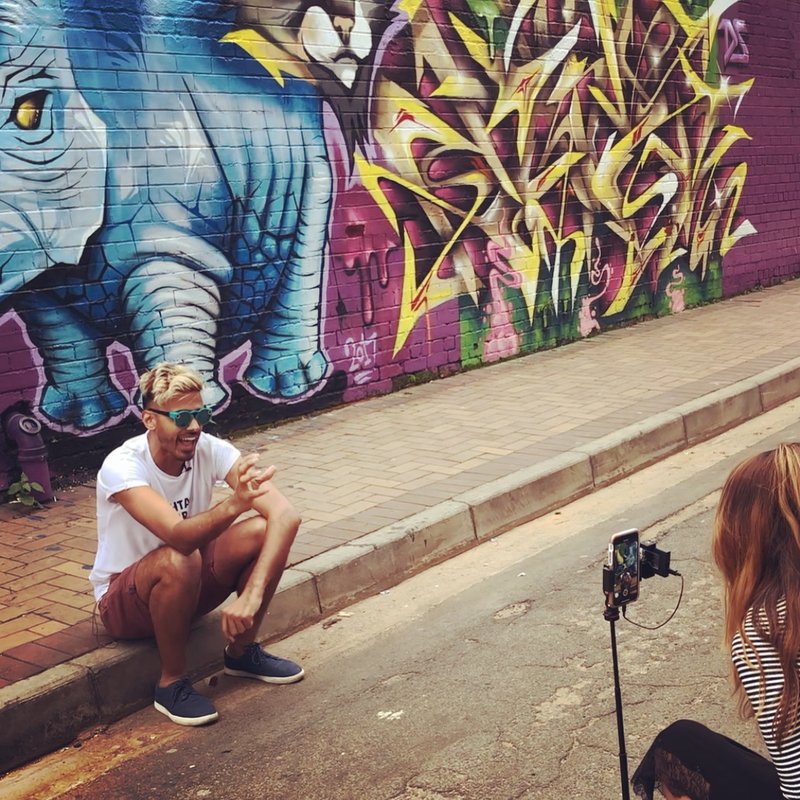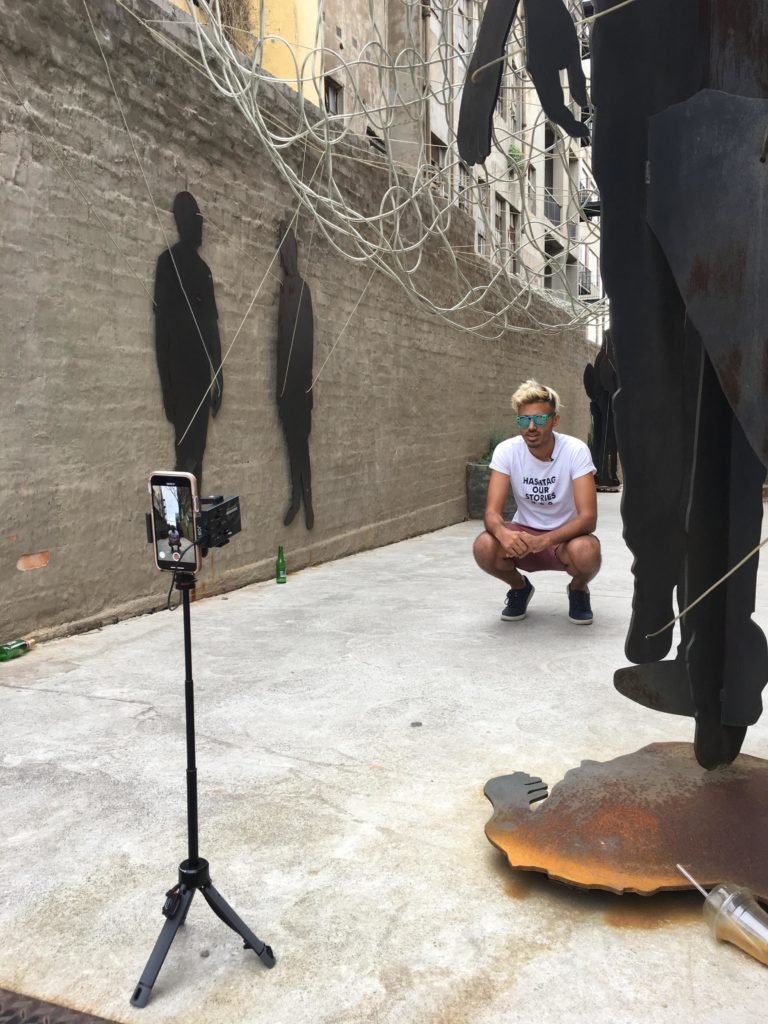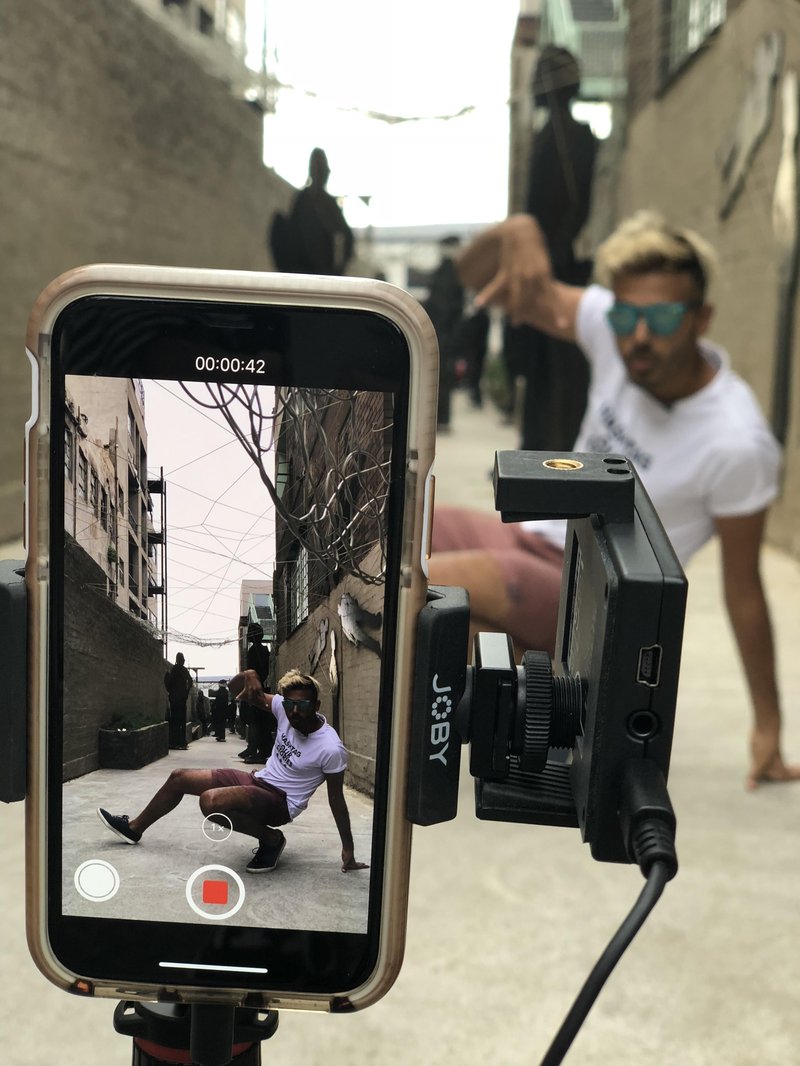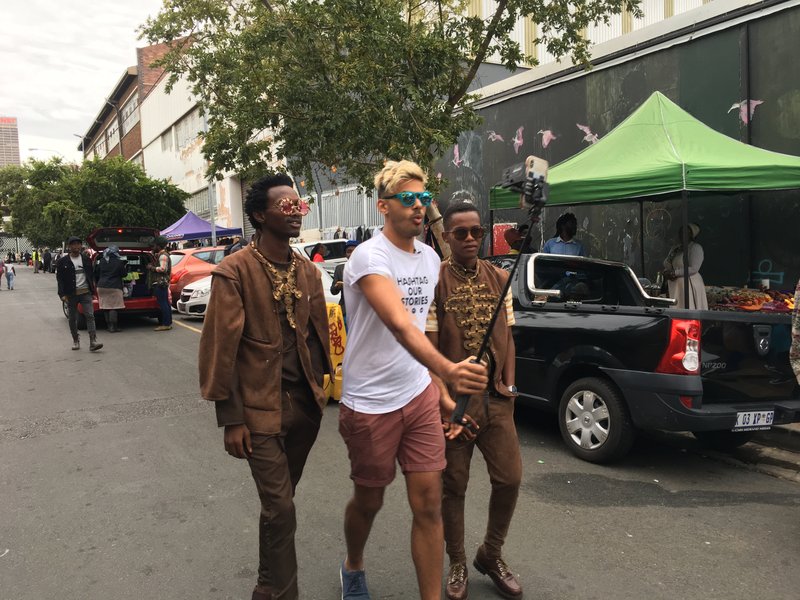Mr. MoJo Risin’ – Yusuf Omar and Hashtag Our Stories
On June 5, 1989, the world watched as video smuggled out of China showed a lone man standing down a row of tanks during the Tiananmen Square democracy demonstrations. In April 2003, online cameras in a hotel window continued to roll as a statue of Saddam Hussein was torn down in Baghdad’s Firdos Square by a rebellious crowd, later aided by US Marines. More recently, it was the rise of social media that helped power the Arab Spring uprising, and the cell phone coverage from Egypt’s Tahrir Square brought that conflict home to the waiting world and helped topple a regime. These events, carried by the internet and social media, helped to pave the way for the concept of mobile journalist.
Some in-the-know analysts predict that mobile journalism is the future of news reporting and storytelling. But for Yusuf Omar, that future is already here. Mr. Omar is one of the world’s leading advocates and proponents for the power of MoJo, or Mobile Journalism. For Yusuf Omar, the Samson Go Mic Mobile is key to capturing audio of the highest quality while on the go. As an award-winning reporter and journalist, Omar has already enjoyed successful stints at eNCA (electronic News Channel Africa), the Hindustan Times, and as the Senior Social Reporter for CNN. Most recently, Yusuf and his wife, Sumaiya Omar, have launched Hashtag Our Stories to pursue their vision of building a platform that empowers everyday people to tell their stories on a larger scale.

Creating Opportunity
As Yusuf Omar describes it, his professional goal was to become a foreign correspondent. After constantly hearing from the media establishment that he was too young, that they were trimming their budgets, that they were no longer dispatching journalists, Omar made the decision to become his own foreign correspondent. In 2010, Yusuf Omar took his mobile phone and a backpack and began his 12,000 kilometer trek, hitchhiking from Durban, South Africa to Damascus, Syria. As he travelled, he uploaded stories and video he had shot along the way. As it turns out, Omar’s timing was serendipitous. By February 2011, he had arrived in Egypt at the time of the Tahrir Square protests marking the tumult of the Arab Spring. In March 2012, Omar was called to Brazzaville, Congo to report on the devastation caused by the explosion of a munitions depot that killed over 250 people, injured thousands, and leveled an area two kilometers in diameter. By his own admission, Omar states the quality of these original stories was unprofessional – the video images from his handheld phone were shaky, etc. “But no one cared,” claims Omar. The stories were too engaging, and they brought a different perspective to the stories of the day. Omar began to see the power of the civilian mobile journalist.
“The Medium is the Message”
In his 1964 opus Understanding Media: The Extensions of Man, Marshall McLuhan stated that “the medium is the message,” explaining that the medium itself defined “the scale and form of human association…” McLuhan could never have anticipated the internet or the influence of social media in our daily lives. Today, social media is the vehicle that brings the world to our laptops, phones and tablets. But what if instead, it were those same individual phones and tablets that brought the world to social media? They way Yusuf Omar describes it, his generation has co-existed with digital cameras and smartphones since birth. “Mobile cameras and oversharing photos and videos don’t scare my generation, it empowers us,” states Yusuf Omar, “we’ve given birth to revolutions in the Middle East and helped expose police brutality in the USA – all with our mobile cameras.” During the following years at eNSA, Hindustan Time, and CNN, Yusuf Omar began to train and mobilize a new breed of mobile journalist. But even those efforts he found unsatisfactory. “Building mobile journalism teams at mainstream news organizations was often about using mobile phones as the fastest way to get stories out of a location,” Omar recalls, “or the cheapest.”

Hashtag Our Stories
In October 2017, Yusuf Omar and his wife Somaiya Omar co-founded Hashtag Our Stories, determined to promote the benefits of mobile journalism throughout the world. “We want to amplify the voices of people who have been ignored for too long by traditional media,” claims Yusuf Omar. “… we are curating from thousands of citizen storytellers because we believe it’s the most accurate way to really understand what’s happening on the ground.” Hashtag Our Stories is training communities to create journalism using their phones. As Omar reminds us, they are not “trying to replace a broadcast camera. We are starting a global news network with the mobile phone at its center from day one.” Armed only with a cell phone and a few well-chosen accessories, the individual is at once eyewitness to events, the reporter sharing the news with the world, the producer and the analyst who can put the story in context by naming the players, narrating the history of the situation, and documenting the human toll.
“Engagement Increases Empathy”
It is clear that one of the issues driving Hashtag Our Stories is preserving human dignity. Hashtag Our Stories believes that more cameras = more perspectives = more truth. Technology and mobile storytelling are evolving together to provide new answers to age old problems. For example, Snapchat filters allowed young Indian rape survivors to tell their stories without revealing their identities, allowing them to express their emotional duress, but sparing them the further risk of being ostracized by their communities, or even their own families. In another instance, a 7-year old girl was using her phone to send updates from her besieged city of Aleppo in Syria, providing the only images coming from the civilian populace there; she was eventually rescued and arrived safely in Turkey. Yusuf Omar described how he feels that engagement can increase empathy. “I believe social video can be used to reconnect people from opposite ends of the web,” Omar continued, adding, “we can create conversations and important debates in the comments section. If we don’t, we continue to isolate the people we call ‘trolls.’ And the more they are isolated, the less empathetic they are to the issues we should all care about – whether that’s equality, democracy, etc…”

Mobile MoJo
If there is a recurring theme in the Yusuf Omar story, it is that of mobility. The ability to be ready to travel, to report, to capture news at a moment’s notice is paramount. Although he once described himself as a jeans journalist, implying everything he needed could be carried in his own pants pockets, his requirements have changes. These days, Yusuf Omar relies on three things: his drone, his phone and the Samson Go Mic Mobile wireless microphone system. The other favorite items in his go-kit are his video glasses, which connect to his phone via Bluetooth® and uniquely film with a round aperture that eliminates the landscape/portrait debate, plus a variety of pop-on lens, a clip on light, and a tripod attachment for placing himself in the frame. All of these items conveniently store in Omar’s backpack, so he can literally grab his bag and go, whenever the opportunity arises.
Superior On-The-Go Audio
The Samson Go Mic Mobile is the first wireless microphone system designed for the mobile journalist. Operating in the reliable 2.4GHz wireless band, the Go Mic Mobile receiver delivers two channels of clean, low-latency digital audio to any iOS or Android device, tablet or laptop. The wireless design attains unparalleled levels of mobility and eliminates unsightly wires from the video frame. According to Yusuf Omar, “You can fix bad lighting in edit. I can even stabilize shaky footage. The one thing I can’t repair later is sh**ty audio.” For Omar, that’s why it’s important for his Samson microphones to be both affordable and accessible. The Go Mic Mobile automatically seeks out the cleanest available channel to deliver a crystal-clear audio signal – while achieving a 100’ (line-of-sight) range.

Taking it to the Streets
Lately, Yusuf Omar has equipped his Go Mic Mobile with two handheld transmitters which feature Samson‘s Q8 professional dynamic microphone capsules. “I like the green light,” Omar confesses, “Here’s a little secret; I don’t monitor audio. I plug and play. Most of my best shoots are done while running through the streets of South Africa or India. And being able to look down and quickly check that both the green lights on the transmitter and receiver are the right color is reassuring during tricky shoots.” Powered by a rechargeable lithium-ion battery, the 2-channel wireless Go Mic Mobile receiver connects securely to the phone using the adjustable bracket arms, and/or hook-and-loop fasteners. The tripod adapter and DSLR shoe bracket provide additional mounting solutions. Lightning, Micro-B, USB-C and USB-A cables are included to ensure the proper connection. An analog connection can deliver the audio signal to a camcorder or DSLR camera.
We would like to thank Yusuf Omar for his contributions in putting together this piece.
Learn more about Yusuf Omar:
Facebook: www.facebook.com/yusufomarSA
Twitter: @YusufOmarSA
